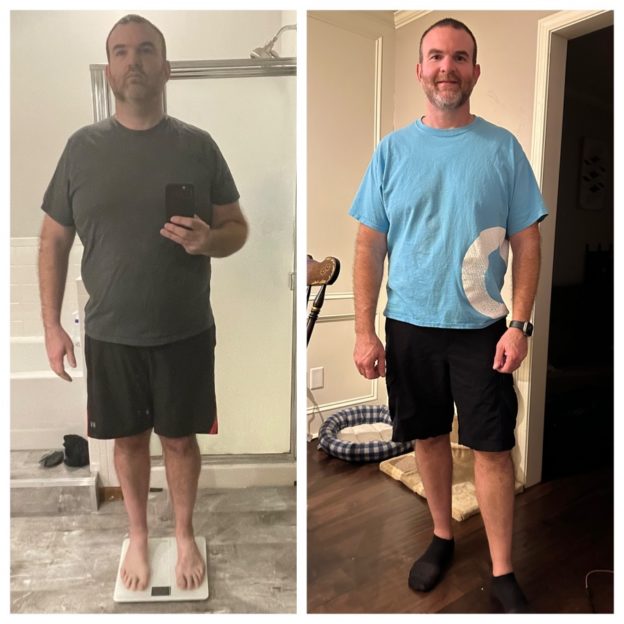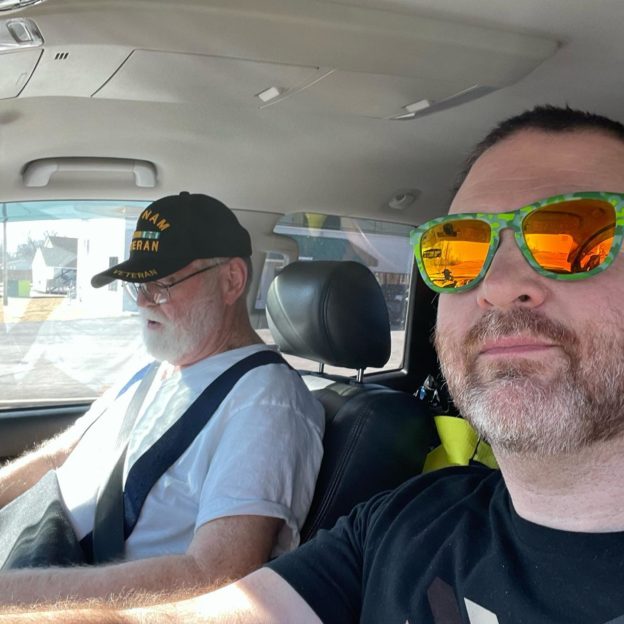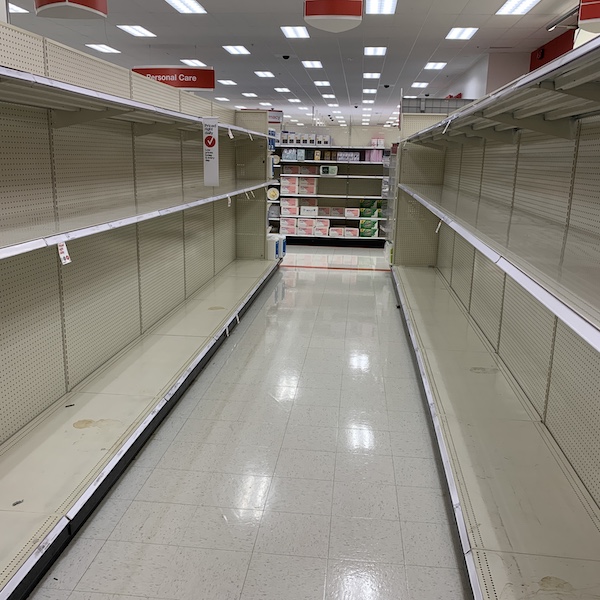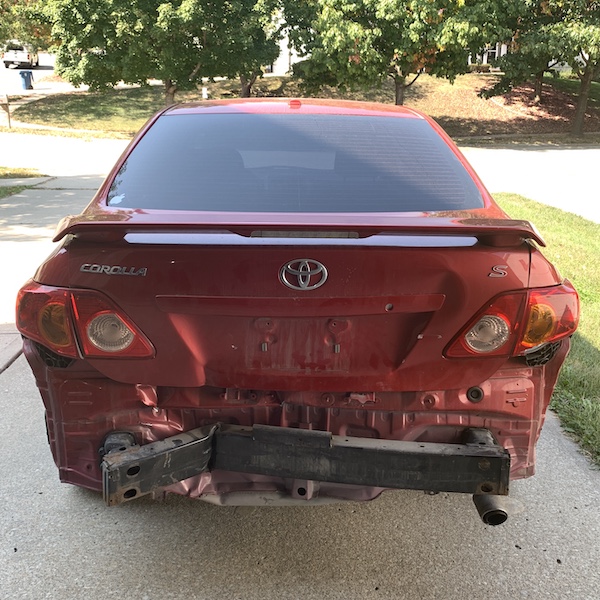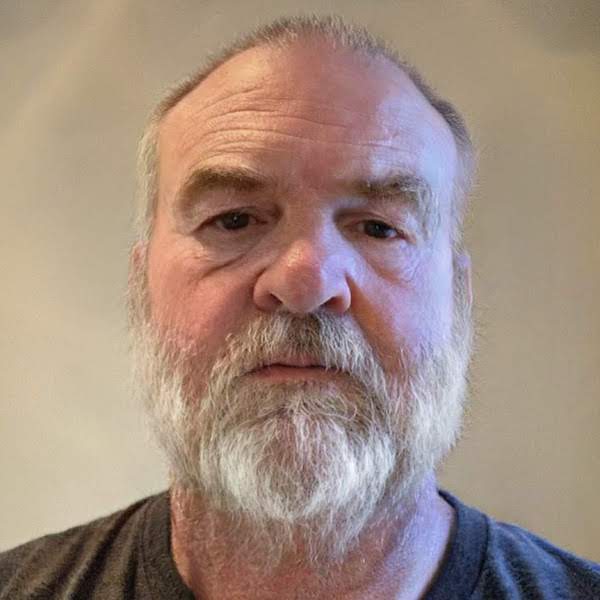If you’re going to go, go all the way.
— Charles Bukowski, ‘Roll the Dice’
In Part One of my 2022 year in review, I talked about how the year was filled with some very personal challenges because of my father’s degrading health, and the death of my grandmother. In this post, I’ll talk about how that prompted me to begin some life changes.
At the first of the year, I was feeling pretty unhappy with how I let myself go, physically. I remember driving my truck and looking down at my stomach and thought, “This is too much. I really need to fix this.”
I snapped a full-body picture of myself (clothed, of course), stepped on the scale, took some measurements, and then got started on a path to change my ways.
It was a slow start.
January 1: 240.2 lbs.
I started with intermittent fasting, but found it rough to break out of the cycle of eat, do nothing physically engaging, and then eat some more. Fasting is like a muscle, and it needs training to get into practice of it. I was very much out of practice. Even though I wasn’t off to the races, at least I started thinking more about what I ate.
February 1: 237 lbs.
After a month of stops and starts with a lackadaisical opening to the year, I found more a groove with intermittent fasting, starting on Valentine’s Day. I finished the last half of the month with longer daily fasts. I discovered that eating on an 18:6 schedule (not eating for 18 hours, then eating for a six-hour window), led to steady decreases in weight. I was traveling a lot this month to run back and forth dealing with issues with dad, and fasting was about the only tool I had available during that busy time. When eating during my six-hour window, I ate whatever I wanted, and starting walking on our basement treadmill.
March 4: 231.6 lbs.
We moved dad into an assisted living facility March 1. The whole month was difficult. I didn’t intermittent fast much, and my physical activity came to a halt for the last two weeks of this emotionally charged month.
April 1: 232.9 lbs.
Since March had little progress on the weight front, I became more focused starting in April. Watching dad degrade so quickly from January through March woke up something within me. Now I wasn’t just wanting to change for my present; I was laying a foundation to try and fight off a similar fate in the future. In mid April, I spent $10 on a day pass to my local community center. I have lifted before, and thought maybe my community center would be enough to get me started down the road to regaining strength.
After we moved dad into assisted living, I brought home some things from the family home from my childhood which included some old action figures. That decision would end up being helpful in the months to come. I sold some of the action figures, and invested the money into my own health: I signed up for a one-month membership to the community center. By the last week of April, I was regularly lifting weights and going for daily walks.
May 1: 228.4 lbs.
Things started to coalesce when I combined resistance training using the 5×5 workout program and daily walking. Intermittent fasting was becoming less a part of my routine, and I started tracking calories with an app called Carbon. As the weather warmed, it became easier for me to get moving more. I wasn’t seeing much when I looked in the mirror, only a glimmer that change was beginning. Most important, however, was that I was building a routine: resistance training was a couple of days per week, and walking was most of my other exercise. I walked a lot.
After selling some more action figures, I signed up for a three-month membership to the community center. I had my plan for the summer.
June 1: 223.4 lbs.
In June, it simply came down to patterns. I would intermittent fast a few times per week in a 16:8 pattern (shortening my fasting window helped with my food cravings that occurred with increased physical activity). I lifted weights, moving forward with progressive overload. I would take one really long walk every Saturday morning (usually four or fives miles), while also walking every morning upon waking. My routine became engrained: wake up, and walk for 30 minutes. Track my food intake with the Carbon app, and try to meet the caloric and protein goals it established for me. Resistance training a few times a week. Over and over, day after day, I was a broken record. It was a simple pattern, repeated over and over for weeks.
By June, my dad’s house was sold. The impact of this weighed on me: my past is truly behind me. Now I must keep building for the future, especially regarding my health.
July 1: 217.3 lbs.
By now I’m seeing a pattern. I’m losing around five pounds per month. I feel more energized, and in turn it pushes me to do more. I walk everywhere for everything. Need a beverage? I can walk to the nearby store for that. How about a few groceries? Yeah, that’s just a slightly longer walk to Walmart for me. I got this idea that maybe I could push hard in July and see if I could reach my goal of 200 lbs. by July 26 (a date I picked because it’s my wedding anniversary). It seemed lofty and too much, but I kept it as a goal anyway. I figured that even if I don’t hit the goal, the work toward it will still be worth it. The second week of July I completed a 45-hour fast (just water).
When July 26 hit, I reached 206.9 lbs. Although short of my goal, it felt like an impressive accomplishment. I was thrilled.
Two days later I would test positive for covid for the first time (and only time, as of this writing).
Aug. 1: 206.6 lbs.
After recovering from covid, I picked up where I left off. It was tough at first, because covid left me feeling wore out and sluggish. I clawed my way back.
A major change I made around this time was the building of a home gym in our basement. I loved going to the community center, but often found myself competing for space on the squat rack, which is where I did most of my work. I figured I could build a home gym with a squat rack and a bench press, then I would be set.
I found almost everything used on Facebook Marketplace. Instead of going to the gym, I brought the gym home to me.
On Aug. 28, I ran a 5k. I had to take four, two-minute walking breaks during the race, but I finished (which in itself felt like a big accomplishment).
Sept. 4: 199 lbs.
It was a goal of mine to get to 200 lbs. or less all year. That became my obsession. You lift, walk, run a little, watch your food intake, and then repeat over and over and over.
And then one day, it just showed up. For the first time in decades, I was under 200 lbs. That was a killer day.
Oct. 1: 203.4 lbs.
By the time I hit my goal in September, I was a little burned out. It’s good to take a break from things every once in awhile, and I was definitely in need of a break. Around this time, I switched my nutrition tracking from Carbon to Macrofactor and but kept up my exercise routine. But the weather was changing into fall/winter temps, which meant that more things were going to be inside from now on.
I dipped below 200 lbs. several times during the month of October, but it wouldn’t stay that way as we entered the Season Where Every Holiday Focuses On Food (Halloween, Thanksgiving, Christmas, and New Year’s Eve).
On Oct. 2, I ran my second 5k of the year. I didn’t stop at all this time.
Nov. 1: 202.2 lbs., Dec. 1: 202.8 lbs.
I have ticked up on the scale, slightly, but I am not discouraged by that. In fact, given all that the last three months focuses on food consumption, I have found it fairly encouraging to be stable for now. I’m fine with stable.
The future
So, the kicker of a question … given all that happened with my dad and his disease, was 2022 a bad year?
Although I’m terribly saddened by the progression of Alzheimer’s Disease in my dad, it got me going to work on my own health. I don’t know what the future holds for me, but I am determined to fight it.
And the funny thing is, what started as a focus on my health, eventually became a focus on what makes me feel fantastic. It’s very difficult for me to have a bad workout. Even if I’m not able to give 100 percent, just the act of working does wonders for my mood.
I have loads more energy to push me to do things with my family. It still makes me feel great when people who haven’t seen me for awhile come up and say, “Wow, what happened to you?” It’s those times when I get to smile, say thanks, and say, “I’ve been working on myself this year.”
In 2023, the journey continues. I’ve had enough time off working through my stability period, but I’m ready to push the reset button and start over. But this time I get the benefit of starting from a different point this time.
All in all, 2022 was a fantastic year. It was a year I found myself again, and I am so glad I did.
On to 2023!
